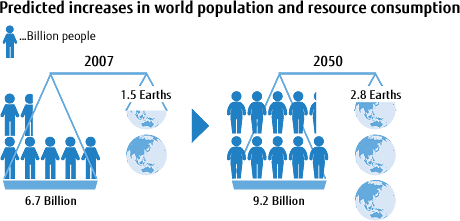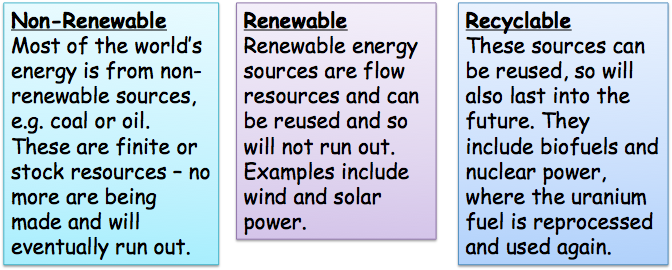Classification of Resources
What Needs Energy?
Energy is essential for modern life. As the world’s population grows and becomes wealthier, the demand for energy is increasing.
This is driving the search for new sources of fossil fuels and alternative sources of energy, the problem being that energy resources are unevenly distributed across the world.
One of the 21st century’s biggest challenges is to manage energy resources and consumption more sustainably.
Resources and Population
Classification
Resource Use
| Coal. Most coal deposits were formed around 300 million years ago during the Carboniferous period. The world was covered in tropical forest then. Over millions of years the wood and other plant matter physically and chemically changed into coal. | Hydro Electric Energy. Hydroelectric energy is generated by the flow of water and like most other renewable energy sources, it is actually indirect solar power which drives the Earth’s water cycle. | Gas. It is usually found with oil deposits and the leading theory suggests that they both formed millions of years ago in places where dead organic material built up on the bottom of oceans, riverbeds or swamps, and got mixed with mud and sand. Depending on how liquid or gaseous this mixture is, it will turn into either crude oil or natural gas. |
| Biomass. All of the Earth’s living material or ‘biomass’ exists in a thin layer around the surface of the planet called the biosphere. It is a huge store of energy that is continually replenished by the Sun through photosynthesis. Biomass is any plant or animal matter, including plant and animal waste and human sewage. Energy crops are plants grown specifically for fuel. | Solar Energy. Solar energy is energy from the Sun. The Sun is a star that produces energy on a massive scale. Nuclear fusion reactions in its core turn 4.3 million tonnes of hydrogen into energy every second. This energy eventually radiates into space, in all directions. Travelling at the speed of light, a small fraction of it reaches the Earth about eight minutes after it leaves the Sun. | Hydrogen fuel cells. Water is a compound made from hydrogen and oxygen. If you pass an electric current through water, it can break the bonds in the molecules and split them into separate hydrogen and oxygen molecules. The oxygen and hydrogen are released as gases and can be collected in separate containers. This process is known as electrolysis. A fuel cell is a device that uses electrolysis in reverse. It converts hydrogen and oxygen into water, producing electricity and heat in the process. |
| Nuclear Energy. Nuclear power is generated by splitting atoms of uranium into lighter elements by firing neutrons at them. This process is called nuclear fission. As the atom splits, it releases more neutrons, which then split more uranium atoms, releasing more neutrons and so on. This is a chain reaction which produces lots of heat energy. | Oil. The leading theory suggests it formed millions of years ago, in places where dead organic material built up on the bottom of oceans, riverbeds or swamps, and was mixed with mud and sand. Over time, more sediment piled on top, and the resulting heat and pressure changed the organic layer into a dark and waxy substance. Depending on how liquid or gaseous this mixture is, it will turn into either crude oil or natural gas. | Geothermal energy. Geothermal energy is a form of renewable energy that is not dependent on the Sun, but on heat that comes from deep below the surface of the Earth in the layer called the mantle. Molten rock from the mantle can rise in places bringing the mantle’s heat nearer the surface and can sometimes even erupt onto the surface as volcanoes. In certain places, like Bath with its famous hot spring baths, natural mineral water can percolate deep down beneath the surface until it gets near to hot areas, is heated up and then returns to the surface as natural hot springs. |

